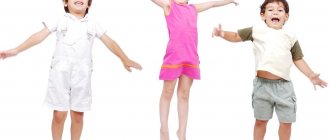Article:
You can’t count the nerve cells that parents lose in endless attempts to please a capricious child.
And the baby’s pouting lips, coupled with the promise to “never be friends with mom and dad again” is the least of the evils. There are also bitter tears, loud hysterics with stamping of feet, constant “I don’t want” and “I won’t.” Real dramas. Let's figure out how to cope with a capricious child. According to psychologists, the tendency to whims in children is associated with their age and psychophysical characteristics. And the younger the child, the more clearly it manifests itself. Psychiatrist Paula Levine of Miami Medical Center says that most mood swings are a normal part of growing up. It is important not to mistake tears and tantrums—even if they happen more often than you would like—for bad behavior, manipulation, and emotional blackmail.
In general, every age has its own whims. And the approaches to their “liquidation” are also different.
Children under one year old
The baby still definitely doesn’t know how to be capricious for the purpose of manipulation. Yes, he often cries to attract his mother’s attention, but this is dictated by a natural fear of being left alone. But not through emotional blackmail; the child will master these “skills” later.
Babies act out and freak out because they are tired, hungry, sick, bored, or teething. There are a lot of reasons.
Under the age of one year, babies, due to an insufficiently developed nervous system and a banal inability to speak, cannot express their emotions in any other way. Hence the whims.
The main task of parents is to calm themselves and calm a capricious baby. But it won’t hurt to learn now how to react correctly to a child’s tears, otherwise there will be much more problems with hysterics in the future.
Deprive your baby of spectators
For recurring tantrums, it is best to isolate the child as soon as the outbreak occurs. If this happens in a public place, move him to a more private place until he calms down. The most extreme option is a corner. And be sure to deny him what he really loves - a cartoon, a walk, games, sweets, etc. The child must realize that his behavior does not deserve games and attention. The length of time he spends in the calming place may vary for different children, but he should remain there for at least two minutes from the moment he calms down. If he starts acting up again, take him back. The most difficult thing here is to maintain your own calm, but this is what will help the child return to a calm state.
Children 1-2 years old
It seems that just yesterday the child was a sweet angel, but today he has become whiny and capricious. Hello, one year crisis. Often this is what causes changes in the baby’s behavior.
This is the first age-related crisis of a child that parents face. It starts at about a year and a half, and ends by 2 years. Psychologists characterize this period as the beginning of the formation of one’s own “I”.
The baby little by little begins to realize that he is an autonomous person. He develops goal-setting when “I want” develops into “I need to achieve it.” In any way - sometimes with screams and hysterics. The child actively explores the world - when for one reason or another he is forbidden to do this, whims become a way to achieve what he wants. And yes, the baby learns to manipulate his parents. He observes their reactions to his various actions, probes the boundaries of what is permitted. It is important not to miss the moment when “real” whims develop into a method of emotional blackmail.
But don’t forget that even now a child can be capricious and freak out for completely “banal” reasons - he’s overtired or sick.
Why is hysteria dangerous?
Surely, your “wise” neighbors have already told you: “It will pass with age!” But they did not say that with age, outbursts of aggression and hysterics go away only in those children whose parents were able to cope with them. If nothing is done about hysteria and “crazy” behavior, then they get worse with age, develop into very unpleasant character traits and remain with the child for life. Advanced neuroses lead to serious mental disorders, insomnia, loss of appetite, chronic fatigue, enuresis, loss of interest in life, nervous tics, etc.
Children 3-4 years old
The whims of a child at this age are a completely normal reaction to insult or stress. He cannot yet cope with emotional stress “correctly”.
And just now the child is entering another age crisis, which begins at 2.5 years and ends at 4 years. A difficult period for both the baby and his parents. Psychologists also call it a crisis of negativism. It was as if the child had been replaced. He is capricious, whiny, irritable, and answers “no” to everything.
Psychologists say that this is a consequence of the formation of the baby’s own “I”. Unconsciously, he tries to separate himself from mom and dad, to prove to them that he can do everything. This is where real revolts against the rules established by parents come from - screams, hysterics, tearful whims. The child cannot yet prove his independence in any other way and defend his opinion, he freaks out and yells. And some flaws in upbringing only aggravate the situation - for example, excessive strictness of parents.
A 3-4 year old child already understands quite well what “good” and “bad”, “impossible” and “possible” are. The baby is quite capable of cunning manipulations, which is why he is often capricious. He managed to understand that loud tantrums in the supermarket usually help to “beg” for toys, and tears on the playground will certainly extend the time of the walk.
A capricious child aged 3-4 years is a signal for parents, a call to reconsider their approaches to parenting. Where did it all start? At what points does a child become unbearably capricious?
The root cause will go away, and the “wrong” behavior will stop.
Teenage crisis
Physiology. At 11-15 years of age, accelerated physical growth and puberty are observed.
Psychology. Against this background, psychological changes occur: increased sensitivity, excitability, mood instability, incontinence, and possible aggressiveness. The desire for independence from adults and self-affirmation provokes rash actions: smoking, alcohol, early sexual intercourse, drugs. Teenagers gravitate toward grouping and spending time with peers. They are selfish and indifferent to others, while they really need the attention and care of adults.
What to do? A teenager should be treated as an adult, capable of making decisions and being responsible for their actions. There is no need to impose your opinion on him; try to lead him to adequate independent decisions. If your teenager's behavior worries you, consult a psychologist.
Age crises are natural. Their course depends on the child’s personality: it can be acute and painful or mild and almost unnoticeable. With the correct behavior of adults, the child overcomes age-related crises, and a calm, friendly atmosphere is maintained at home.
Children 5-7 years old
The whims of children at this age can hardly even be called whims. Rather, it is an established norm of behavior, the habit of getting one’s way not through dialogue, but by screaming and crying. Manipulation in its purest form. Most likely, the parents missed the most important moment when they could still change their reaction to the baby’s protests.
School also changes a child’s behavior. It is difficult for him to adjust to a new regime after kindergarten. Hence the tearfulness and sometimes inadequate reaction to what is happening around, the reluctance to go to school, and poor behavior in class. Problems are exacerbated by poor socialization and lack of self-confidence. Scolding and “teaching life” to a capricious child is pointless. It is important to help him overcome another age crisis. When the child adapts to school, problems with frequent whims will go away.
“Prevention” of children's whims: 3 important recommendations
It is much easier to prevent a child’s capricious behavior than to then “treat” it a hundred times a day. What parenting techniques will be helpful?
A clearly structured “don’t” system
Children 1-3 years old in most cases react to prohibitions with whims. It turns out that if you remove all the “don’ts,” the child will stop constantly throwing tantrums. No, that's not quite the right approach. At least for the safety of the child, prohibitions should exist. Not to mention the standards of education.
But these must be clear and specific prohibitions. These are unshakable rules that cannot be broken - even on weekends, when sick, or at grandma's. Systematic “don’ts” provoke protests. A capricious child reasons like this: his parents sometimes allow him to watch cartoons until the night, which means that if he cries a little, they will make an exception today. If the “bedtime at 9” rule worked all the time, then there would be no tears in the evenings.
The child must understand what “no” is
Why do those terrible hysterics happen in the store over an unpurchased toy? The child does not understand or does not want to understand the word “no”.
It's one thing if a one-year-old child is crying - most likely, he is really upset that his mother did not give him that car. Naturally, the baby expresses anger and dissatisfaction by screaming - he still doesn’t know how to do it any other way. Here you need to calm the child down or distract his attention - the stress will be relieved.
But it’s a completely different matter when a 3-6 year old child throws such a tantrum. He perceives a parent’s “no” as a call to action. And since he is capricious, despite the reasonable arguments of his parents, it means he understands: “push a little more, and mom and dad will agree to anything.” Manipulation, a way to get what you want.
If there is an understanding that the parent’s “no” is as unshakable as a rock, there will be a minimum of whims at 2-4 years old, when the child is actively testing the boundaries of what is permitted.
Here again the question is a clearly structured system of prohibitions. Psychologists advise all family members to adhere to the same strategy for raising children. Otherwise, with a mother who periodically says “yes” instead of “no,” the child will be especially capricious; with a father, this will not help achieve what he wants.
And of course, “no” should not be shouted out in irritation, but spoken calmly. And it is advisable to explain your refusal.
Down with overprotection
Psychologists advise not to do for a child what he is quite capable of doing on his own. A bad parenting habit that over time can become a trigger for tantrums and whims. If you perform the simplest tasks for a child over and over again - cleaning up scattered toys for him or getting him dressed for kindergarten in the morning - at one point you can hear the completely natural “I don’t want” and “I won’t” in a whiny voice. Why should a child try if the mother can do everything perfectly herself? He is capricious, dependent, indecisive.
In general, overprotection is an unimportant assistant in raising a child. Already at one year old, you can put away his toys with your child, showing him how to do it correctly - this reinforces useful behavior patterns. This means that at 2-3 years old there will be no whims about the need to clean up.
Let your baby feel independent
The crisis of three years always manifests itself in a child with increased independence. The kid tries to do everything himself, even though his capabilities do not always correspond to his desires. Parents need to be understanding of such aspirations. Try to be more flexible in your upbringing, don’t be afraid to somewhat expand the responsibilities and rights of the baby, let him feel independent, of course, only within reasonable limits, certain boundaries must still exist. Sometimes ask him for help or give him some simple instructions. Never interfere in your child’s activities unless he asks you to!
The whims have begun: what should parents do?
Even the most obedient kids get capricious and freak out. This is fine. And there is no universal recommendation that would help instantly extinguish a child’s hysterics. After all, the reasons for whims themselves may be different.
With babies aged 6 months, everything is more or less clear. You need to pull yourself together and calm the baby. Here everyone copes as best they can - rocks, sings a song, gives a favorite toy or rodent to relieve pain in the gums. If necessary, feed, drink and put to bed. “Bad days” happen even to young children - most likely, tomorrow the child will be in a better mood, he will not be capricious, freak out and cry.
But starting from the age of one year, the “pump and feed” techniques will no longer work. How to cope with the situation and quickly extinguish whims?
Switch the child's attention
Perhaps the baby did not plan anything bad - he began to be capricious and freak out because he was tired or bored. Try to switch his attention to something else. Works flawlessly with children 1-2 years old.
Has your child started acting up in the store? Distract him with a toy (be sure to put it in your bag). Or involve your child in helping - let him get food from the lower shelves.
Use reasonable arguments
If your child suddenly goes crazy, try to come to an agreement with him. After 3 years, he is quite capable of understanding that “wrong” behavior can be followed by punishment. It's time to learn how to negotiate peacefully with your child.
Of course, we will do without threats and severe punishments. We calmly explain why exactly “no” and “impossible.” Most likely, a capricious child listens to reasonable arguments when tearfulness is periodic in nature.
If necessary, we promise to do what he wants another time. By the way, the promise will have to be fulfilled so as not to shake the baby’s trust. Otherwise, next time it will not be possible to extinguish his whims.
Recourse to the help of the “hall”
A great way to distract a 1-2 year old child from his own whims is to call a friend, a “figurehead,” for help.
We take the baby’s favorite toy and say: “I’m very sad. Let's go for a walk". Most likely, the child will forget that he cried. Of course, he understands that this is mom. But he will certainly enjoy this performance.
Act on the contrary
A three-year-old suddenly has an “attack” of negativism, is he capricious and freaking out, as happens during an age crisis? When he says “no” to everything, try doing the opposite.
If you want to go right, say left. Most likely, the baby will begin to walk to the right. And when you need to feed your child meat, tell him that he can’t have that delicious piece at all. He'll probably eat it with pleasure. From time to time, when the situation allows, you can cope with children's whims in this way.
Suppress a child’s negative emotions with a comic fight
If a child throws a tantrum or is naughty at home, you can offer him a comic fight with pillows or soft toys. A great way to release stress and negative emotions is to channel your anger into a peaceful channel.
Don't leave the child alone
When a child is capricious and freaks out, emotions go through the roof - it seems that it is no longer possible to tolerate it. Find the strength to stay close and talk to your child. Don't leave him alone with stress.
Hug, hold close. Tell him you understand him. Explain once again the prohibition or, conversely, the need to do something. If this does not calm the fussy child, stay in the room nearby. Surely the grievances will soon pass.
Main features
All children are individual, therefore, even if they fall into hysterics, each child behaves differently. Some scream loudly and stomp their feet in the hope of getting their way, others completely lose control of themselves and begin to roll on the floor. But this is not as scary as if aggression begins to appear. In this case, the child may cause harm to himself or others. If parents have already studied this process, then they roughly understand what will happen to their baby when they fall into hysterics. This will allow you to take security measures. As a rule, before throwing a tantrum, many children begin to behave characteristically. If adults manage to catch the right moment, they can try to prevent an attack.
There are special precursors to hysteria that signal an approaching attack. The child may begin to methodically rock his body, whine, snore, or grumble. His eyes fill with tears, his lips are pursed, his face turns red, his movements become sharp and nervous. However, the warning signs of hysteria may not always appear. Sometimes an attack begins unexpectedly.
What does the child do:
- screams and cries a lot;
- pounding with hands and feet;
- bangs his head against the wall;
- pushes and fights, bites himself;
- falls to the floor;
- coughs, breathes intermittently;
- in the process of rolling on the floor, he arches his back, which is involuntary spasms.
In addition, in hysterics, a child demonstrates a lack of reaction to words addressed to him by adults. Also, a child may, in a fit of aggression, shout at the adult at whom the hysteria is directed, use offensive words, or call him names.
What emotions are typical for a child at the time of an attack:
- aggression;
- resentment;
- anger;
- disappointment;
- irritation;
- anger.
When a child begins to have a tantrum, he is in a state of passion. This means that the child is completely unable to control himself. In case of self-harm, the baby does not feel pain at all at that moment. Undoubtedly, observing such behavior of your beloved child is scary and unbearable. If an adult has witnessed such a scene, he should know what measures to take to help the child calm down and come to his senses as quickly as possible.











